Advantages and Disadvantages of Different AAC Block Sizes
AAC (Autoclaved Aerated Concrete) blocks have gained significant popularity in the construction industry due to their lightweight, thermal insulation properties, and ease of handling. However, when it comes to choosing the right AAC block size for a project, there are several factors to consider. Let’s delve deeper into the advantages and disadvantages of different AAC block sizes.
Understanding AAC Block Sizes
AAC blocks are available in various sizes to cater to different construction needs. Common sizes include standard, medium, and jumbo blocks, with dimensions ranging from small bricks to larger panels. The choice of size depends on factors such as project requirements, structural design, and ease of handling.
Advantages of AAC Block Sizes
Lightweight Construction Material: One of the primary advantages of AAC block sizes is their lightweight nature. Compared to traditional bricks or concrete blocks, AAC blocks are significantly lighter, making them easier to handle and transport. This characteristic reduces labor costs and speeds up construction timelines.
Enhanced Thermal Insulation Properties: AAC blocks offer excellent thermal insulation, helping to regulate indoor temperature and reduce energy consumption. By choosing the right block size, builders can optimize thermal performance, ensuring comfort and energy efficiency in buildings.
Ease of Handling and Installation: Smaller AAC block sizes are easier to handle and install, especially in tight spaces or intricate designs. This ease of handling contributes to faster construction and minimizes the risk of breakage or damage during transportation and installation.
Customizable Sizes for Various Construction Needs: From standard bricks for wall construction to larger panels for flooring or roofing, AAC block sizes can be customized to suit specific project requirements. This versatility allows builders to achieve design flexibility and structural integrity in diverse applications.
Disadvantages of AAC Block Sizes
Limited Load-Bearing Capacity for Larger Sizes: While AAC blocks offer excellent strength-to-weight ratio, larger sizes may have limited load-bearing capacity compared to traditional concrete blocks. Builders need to consider structural requirements and reinforcement measures when using larger AAC blocks in construction.
Higher Initial Cost Compared to Traditional Bricks: The initial cost of AAC blocks, especially larger sizes, may be higher than that of traditional bricks or concrete blocks. However, the long-term benefits in terms of energy savings, durability, and reduced maintenance costs often outweigh the initial investment.
Specialized Skills Required for Cutting and Handling Large Sizes: Handling and cutting larger AAC blocks require specialized equipment and skills, adding to the overall project costs. Builders need to factor in additional expenses for equipment rental or hiring skilled labor when working with larger block sizes.
Comparison with Other Construction Materials
AAC Blocks vs. Traditional Bricks: AAC blocks offer superior thermal insulation and ease of handling compared to traditional clay bricks. While bricks are more cost-effective for small-scale projects, AAC blocks provide long-term savings through energy efficiency and durability.
AAC Blocks vs. Concrete Blocks: AAC blocks and concrete blocks both offer strength and durability in construction. However, AAC blocks have the added advantage of being lightweight and providing better thermal insulation, making them ideal for sustainable building practices.
Applications of Different AAC Block Sizes
AAC blocks find applications in various construction projects, including residential buildings, commercial complexes, and infrastructure development. Smaller block sizes are suitable for interior walls and partitions, while larger panels are used for external walls, flooring, and roofing.
Sustainability of AAC Blocks
AAC blocks are considered environmentally friendly due to their low carbon footprint and energy-efficient manufacturing process. The use of recycled materials and minimal energy consumption during production further enhances the sustainability credentials of AAC blocks.
Conclusion
Choosing the right AAC block size is crucial for optimizing construction efficiency and achieving desired structural performance. While different sizes offer unique advantages and disadvantages, builders can leverage the versatility and sustainability of AAC blocks to create durable and energy-efficient buildings.
FAQs:
- Are AAC blocks suitable for load-bearing walls?
- Yes, AAC blocks can be used for load-bearing walls, but builders need to consider structural design and reinforcement requirements, especially for larger block sizes.
- What factors should I consider when selecting AAC block sizes for my project?
- Project requirements, structural design, ease of handling, thermal insulation properties, and budget constraints are key factors to consider when choosing AAC block sizes.
- Can AAC blocks be cut to custom sizes on-site?
- Yes, AAC blocks can be cut to custom sizes using specialized equipment. However, this process requires skilled labor and may incur additional costs.
- Are AAC blocks more expensive than traditional bricks?
- While AAC blocks may have a higher initial cost, they offer long-term savings through energy efficiency, durability, and reduced maintenance expenses.
- Are AAC blocks environmentally friendly?
- Yes, AAC blocks are considered environmentally friendly due to their low carbon footprint, energy-efficient manufacturing process, and recyclable materials.
Disclaimer: The views expressed above are for informational purposes only based on industry reports and related news stories. PropertyPistol does not guarantee the accuracy, completeness, or reliability of the information and shall not be held responsible for any action taken based on the published information.




